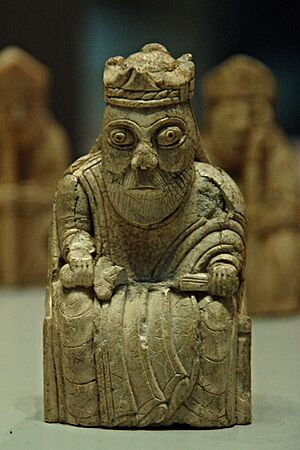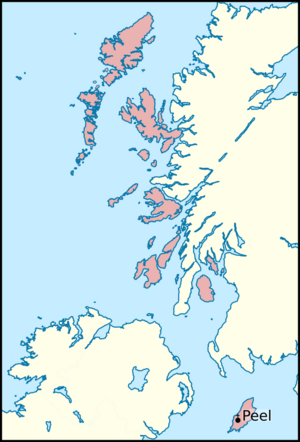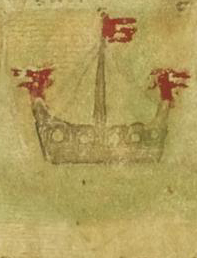Dubgall mac Somairle facts for kids
Quick facts for kids Dubgall mac Somairle |
|
|---|---|
| King of the Isles | |

Dubgall's name as it appears on folio 16v of British Library Cotton Domitian A VII (the Durham Liber vitae): "Dunegal fili(us) Sumerledi".
|
|
| Died | 1175 |
| Issue |
|
| House | Clann Somairle |
| Father | Somairle mac Gilla Brigte |
| Mother | Ragnhildr Óláfsdóttir |
Dubgall mac Somairle (died 1175) was an important leader in the Kingdom of the Isles. He was the son of Somairle mac Gilla Brigte and Ragnhildr Óláfsdóttir. Dubgall was a key figure in Clann Somairle, a powerful family group. He is also the ancestor of Clann Dubgaill, a famous Scottish clan. We don't know much about Dubgall's life, but he played a part in big changes in the Isles.
In 1155 or 1156, Dubgall was suggested as a new king for the Isles. At that time, his uncle, Guðrøðr Óláfsson, was the king. Later that year, Dubgall's father, Somairle, defeated Guðrøðr. The kingdom was then split between them. Two years later, Somairle beat Guðrøðr again. He took control of the whole kingdom. Dubgall might have been called "King of the Isles," but his father held the real power.
Dubgall's father died in 1164 during a fight in Scotland. It's not known if Dubgall was there. After Somairle's death, his uncle Rǫgnvaldr Óláfsson became king. But Guðrøðr soon defeated Rǫgnvaldr. Even so, the lands Somairle had taken in 1156 stayed with Clann Somairle.
Dubgall is last mentioned in 1175. He made a gift to St Cuthbert at Durham Cathedral in England. While his father was more traditional in his religious views, Dubgall and his brothers supported newer religious groups. It's possible that Dubgall, his father, or his brother Ragnall helped start the Diocese of Argyll, a church area.
We are not sure how Clann Somairle's lands were divided. But Dubgall might have ruled Lorne on the mainland. He may also have ruled the Mull islands in the Hebrides. We don't know when Dubgall died. It seems his brother Ragnall might have taken over from him at some point. Ragnall and another brother, Aongus, later fought over who would lead Clann Somairle. Even though Ragnall seemed more powerful, Dubgall's descendants, Clann Dubgaill, became the strongest branch of the family until the 1300s.
Contents
Dubgall and the Kingship of the Isles
The year 1153 was a turning point for the Kingdom of the Isles. In June, King Óláfr was killed by his nephews while his son, Guðrøðr, was away. Within months, Guðrøðr defeated his cousins and became king. During his rule, both Guðrøðr and Somairle fought in Ireland. For example, in 1154, soldiers from the Isles helped Muirchertach Mac Lochlainn, King of Cenél nEógain win a battle. Guðrøðr also tried to become king of Dublin but failed. These problems might have made Dubgall's father, Somairle, decide to act.
In 1155 or 1156, a historical record called the Chronicle of Mann says that Somairle took power from Guðrøðr. It mentions that a leader named Þorfinnr Óttarsson suggested Dubgall as a replacement for Guðrøðr. The chronicle calls Dubgall the "chosen son." This might mean he was the oldest or most important of Somairle's sons. However, not everyone supported Somairle's plan. Some leaders had to promise loyalty and give hostages. One chieftain even warned Guðrøðr about Somairle's actions.

Late in 1156, Somairle and Guðrøðr fought a fierce sea battle. It happened on the night of January 5th/6th. The battle was very bloody but didn't have a clear winner. The chronicle says Somairle had eighty ships. After the fight, the two men, who were brothers-in-law, divided the Kingdom of the Isles.
We don't know exactly how the kingdom was split. But later, Somairle's family controlled the southern islands of the Hebrides. Guðrøðr kept the northern islands and Mann. So, Somairle likely got control of Islay and Mull. Guðrøðr kept Mann and the rest of the Hebrides. Two years later, Somairle attacked Mann with fifty-three ships. He drove Guðrøðr out of the kingship and into exile.
With Guðrøðr gone, either Dubgall or Somairle became King of the Isles. Dubgall might have been the official king, but the chronicle makes it clear that Somairle had the real power. Irish records also called Somairle a king later in his life. We don't know why the people of the Isles chose Dubgall instead of Somairle. Perhaps Somairle wasn't acceptable for some reason. Dubgall's mother was from a royal family, which might have given him more credibility. It wasn't unusual for a powerful leader to set up his son as king under his own control. For example, Magnús Óláfsson (died 1103), King of Norway did this with his son Sigurðr Magnússon (died 1130).
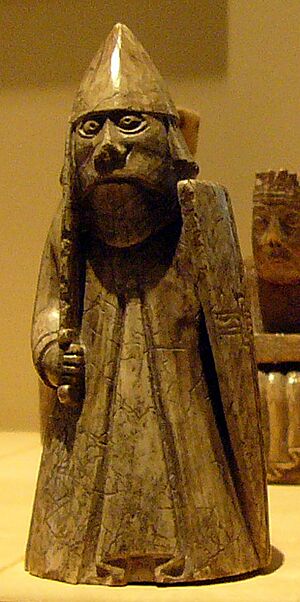
It's possible that Somairle's victory over Guðrøðr was helped by an alliance with Muirchertach. For example, soldiers from Argyll were part of Muirchertach's army in 1154. If Muirchertach and Somairle were allies, Guðrøðr would have faced a strong combined force. However, Somairle and Muirchertach later argued over church matters. This suggests they were rivals at other times.
After Somairle: Clann Somairle Succession
Somairle died in 1164 during a sea invasion of Scotland. This led to a terrible battle near Renfrew. Records show that Somairle's forces came from Argyll, Dublin, and the Isles. This shows how powerful he was. Several sources say one of Somairle's sons was killed in the battle. It's not known if Dubgall was there.
It's possible Dubgall held power after his father died. But the Chronicle of Mann says that Guðrøðr's brother, Rǫgnvaldr Óláfsson, took the kingship before the end of that year. Soon after, Guðrøðr arrived on Mann and defeated his brother. Guðrøðr then became king again. The kingdom was divided between his family (the Crovan dynasty) and Clann Somairle. This division was based on Somairle's earlier victory in 1156. The chronicle even says the Kingdom of the Isles "fell" when Somairle's sons "took possession of it." This might mean Somairle's sons held part of the kingdom even before their father died.
We are not sure about the leadership of Clann Somairle after Somairle's death. The Chronicle of Mann suggests Dubgall was the main leader in the 1150s. But his last mention doesn't give him a royal title. It's possible that Dubgall was replaced by Ragnall. Ragnall was called "king of the Isles, lord of Argyll and Kintyre." This suggests he controlled the Clann Somairle lands. We don't know how or why Dubgall was replaced.

There's no direct proof that Somairle's lands were split after he died. But it's likely his sons divided them. Later generations of Clann Somairle had clear land divisions. But this was probably not the case in the chaotic 1100s. The first generation of Clann Somairle might have controlled lands from Glenelg in the north to Mull of Kintyre in the south. Aongus might have ruled the north. Dubgall might have been in Lorne with most of the family's inheritance. Ragnall might have ruled Kintyre and the southern islands.
It's also thought that Dubgall controlled the Mull islands. An old history from the 1600s, the Sleat History, says Dubgall's lands were only in Lorne. This source also claims he had no right to inherit lands in the Isles. It says he took control of the Mull islands without a good reason. This source tries to connect another family, the MacDonald of Ardnamurchan, to the coastal areas of Moidart and Ardnamurchan. But when Ardnamurchan is mentioned in 1293, it seems to have been part of the lands held by Dubgall's family.
Dubgall's Visit to England

After his role in his father's takeover in 1156, Dubgall is next and last mentioned in 1175. He visited Durham Cathedral in England. This was just before the feast of St Bartholomew (August 23). A book from Durham records his gifts: two gold rings and a promise of one mark every year for life to St Cuthbert.
Dubgall's visit was likely connected to events in York. That same year, William I, King of Scotland and other Scottish leaders swore loyalty to Henry II, King of England in York.
When Dubgall made his gift, he was with his chaplain, Stephen, and a man named Adam de Stanford. All three were accepted into the church community of Durham. The record says Dubgall's gift was made "at the feet of the saint." This means it happened before an image of St Cuthbert, or at his shrine.
Another old book, the Durham Liber vitae, also confirms Dubgall was in Durham. It lists his name with Stephen and Adam. It also lists three of Dubgall's sons: Amlaíb, Donnchad, and Ragnall. If his sons were there, it's not clear why they weren't also accepted into the church community.
Church Changes and Foundations
The church area in the Kingdom of the Isles was called the Diocese of the Isles. We don't know much about its early history. It later became part of the Norwegian Archdiocese of Niðaróss. This reflected the political control Norway had over the Kingdom of the Isles. However, by the end of the 1100s, a new church area, the Diocese of Argyll, started to appear. This happened during ongoing conflicts between Clann Somairle and the Crovan dynasty.
The early leaders of the Argyll church area are not clear. But this area was outside the Crovan dynasty's control. This allowed Clann Somairle to support the church without outside interference. The large size of the Diocese of the Isles likely caused it to break apart. Parts of the Diocese of Argyll might have also been separated from other Scottish church areas. The Scottish king might have liked the new diocese. It could help him extend his power into the region. But Clann Somairle leaders were often against the Scots. The main church on Lismore was far from the Scottish king's control.
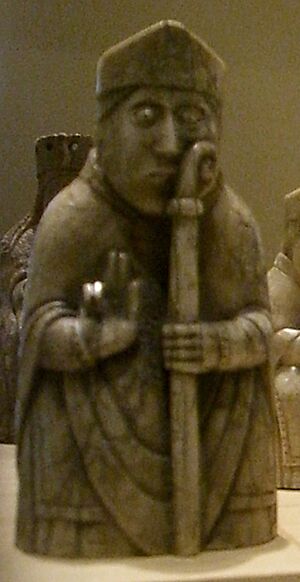
Starting the Diocese of Argyll was a long process. It was probably not the work of just one person, like Somairle, Ragnall, or Dubgall. Dubgall's visit to Durham might show he was close to William I, King of Scotland. If William I helped create the diocese, he might have supported the lords of Argyll in their church efforts. The friendly relationship between William I and Dubgall could mean Dubgall was involved. Even though the early diocese had long periods without a bishop, it became strong over time. This allowed Clann Somairle leaders to keep local control of church power.
It's thought that Somairle and his sons gained influence in the Diocese of the Isles. They might have appointed a man from Argyll, Christian, as Bishop of the Isles. Dubgall himself might have appointed Christian. Christian's time as bishop lasted from about 1170 to the early 1190s. His appointment might have shifted the church's focus away from Mann towards lands controlled by Clann Somairle.
Somairle was more traditional in his religious beliefs compared to his sons. In 1164, he tried to move a church leader to Iona. This was an attempt to bring back the old church leadership to Iona. But his descendants did the opposite. They destroyed the old monastery on Iona and built a new Benedictine monastery. The new monastery was founded in December 1203. This suggests Ragnall might have started it. An old book, the Book of Clanranald, says Ragnall was the founder. But there's no strong proof. The monastery received many gifts from across Clann Somairle's lands. So, other leaders like Dubgall (if he was still alive) or Donnchad likely supported it. Dubgall's visit to Durham shows he supported the Benedictine order. The new monastery was placed under the protection of Pope Innocent III. This gave it independence from the Diocese of the Isles.
Bethóc, Somairle's daughter, was likely the first leader of Iona Nunnery. This Augustinian nunnery might have been built around the late 1100s or early 1200s. The Book of Clanranald says Ragnall founded this house too. Bethóc's tombstone also confirms she was a prioress on Iona. Dubgall's gift in Durham, along with the new monasteries on Iona, show big changes in the church life of the Isles during the 1100s and 1200s.
Dubgall's Descendants
Dubgall's visit to Durham is one of the few times Clann Somairle was connected to the Scottish kingdom before the late 1200s. We don't know anything else about Dubgall or when he died.
Dubgall was the ancestor of the Clann Dubgaill branch of Clann Somairle. The other two main branches, Clann Ruaidrí and Clann Domnaill, came from sons of Dubgall's brother, Ragnall. Some old family trees call Dubgall's descendants "Clann Somairle." This might mean Dubgall and his family were seen as the main line of Somairle's descendants.

We don't know much about Dubgall's sons Amlaíb and Ragnall, other than their mention in the Durham book. Old Scandinavian records say Dubgall had a son also named Dubgall, who was called "screech." Both Donnchad and this Dubgall, along with a relative named Somairle, took part in a Norwegian invasion of the Isles in 1230. The leader of this campaign was Óspakr-Hákon, who might have been another son of Dubgall. Scandinavian sources say Óspakr-Hákon was a brother of Dubgall's sons Dubgall and Donnchad. Óspakr-Hákon became King of the Isles with the help of Hákon Hákonarson, King of Norway. Donnchad is last mentioned in 1237.
About 35 years after Dubgall's last mention, historical records show growing problems among Clann Somairle. For example, in 1209, Ragnall's sons attacked people on Skye. In 1210, Aongus and his three sons died in battle on the same island. These events might mean Ragnall's sons were trying to take control of Skye. They might have killed Aongus and his family there. This could mean Aongus had become the leader of Clann Somairle, and Ragnall's sons fought back. If so, Ragnall's son, Ruaidrí, might have taken over the leadership after Aongus's family was wiped out. These battles in the Hebrides might show a big change in who controlled Clann Somairle's lands.

Earlier, in 1192, the Chronicle of Mann says Ragnall was defeated by Aongus in a very bloody battle. The chronicle doesn't say where or why they fought. But it might have been in the northern part of Clann Somairle's lands, where Aongus had territory. This fight could have been about Ragnall gaining power. Or it could have marked Ragnall's downfall, or even his death.
Even though Dubgall might have been overshadowed by Ragnall, Dubgall's descendants became more powerful than Ragnall's by the mid-1200s. By the 1240s, Clann Dubgaill was the strongest family on Scotland's west coast. They started to form alliances with important families in eastern Scotland. Clann Dubgaill remained powerful in the west until they lost their influence in the 1300s, during the reign of Robert I, King of Scotland.


